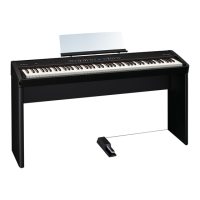Detailed Function Settings (Function Mode)
Parameter Value Explanation
Personalizing Your Piano (Piano Tone)
Lets you personalize your piano sound by adjusting various elements that aect the sound: the piano’s physical strings, the
resonance produced by the pedals, the sound of hammers striking the strings, and more.
Stretch
(Stretch Tuning)
OFF, ON
This lets you specify the amount of “stretch tuning,” a tuning method specically for pianos, in which the high
range is tuned slightly sharper, and the low range is tuned slightly atter.
If you select “ON,” a standard tuning curve created for the FP-50 will be used.
Dmpr Res
(Damper Resonance)
OFF, 1–10
This adjusts the damper resonance of the acoustic piano sound (the sympathetic vibration produced in strings
other than those actually played when you press the damper pedal).
Higher settings will make the sympathetic vibration louder.
Strg Res
(String Resonance)
OFF, 1–10
This adjusts the string resonance of the acoustic piano sound (the sympathetic vibrations of strings for
previously played notes that occur when you play another note).
Higher settings will make the sympathetic vibration louder.
KO Res
(Key O Resonance)
OFF, 1–10
This adjusts sympathetic vibrations such as an acoustic piano’s key-o sound (the subtle sound that occurs
when you release a note).
Higher settings will make the sympathetic vibration louder.
Cabinet
(Cabinet Resonance)
OFF, 1–10
Adjusts the body resonance of the grand piano itself.
Higher values will produce a larger body resonance.
Sound Brd
(Soundboard Behavior)
OFF, 1–10
When you play a chord, this setting improves the clarity of the individual notes in the chord, creating a more
beautiful resonance.
Higher settings produce a clearer resonance.
Trnspose
(Transpose Mode)
Specifying What to Transpose (Transpose Mode)
This setting species what the transpose will aect. You can use the transpose to change the pitch of both the song and the keyboard, the
pitch of only the song, or the pitch of only the keyboard.
KBD Keyboard only
SONG Song play only
BOTH Both keyboard play and song play
Dual Bal
(Dual Balance)
Adjusting the Dual Play Volume Balance (Dual Balance)
You can adjust the volume balance between the two tones (tone 1 and tone 2) used for Dual Play (p. 14).
MEMO
During Dual play, you can also adjust the volume balance between tone 1 and tone 2 by holding down the TONE button
and pressing the [ BACKING] or [KEYBOARD ] button.
9-1 (tone 1 is louder)–9-9 (same volume)–1-9 (tone 2 is louder)
SplitBal
(Split Balance)
Adjusting the Split Play Volume Balance (Split Balance)
You can adjust the volume balance between the two tones (right-hand tone and left-hand tone) used for Split Play (p. 15).
MEMO
During Split play, you can also adjust the volume balance between the right-hand tone and left-hand tone by holding
down the TONE button and pressing the [
BACKING] or [KEYBOARD ] button.
9-1 (left-hand tone is louder)–9-9 (same volume)–1-9 (right-hand tone is louder)
Oct Shft
(Octave Shift)
Changing the Pitch of the Tone in Octave Steps (Octave Shift)
You can change the pitch of the Tone 2 in Dual Play (p. 14) and Left-hand tone in Split Play (p. 15) an octave at a time.
Altering the pitch in one-octave units in this way is called “Octave Shift.”
For example, you can raise the pitch of the Left-hand tone to the same pitch of the Right-hand tone in Split Play.
-2–0–+2 (octave)
Rhy.Part
(Rhythm Part)
You can select a drum-only rhythm part.
REFERENCE
For details, refer to “Selecting Specied Rhythm Parts” (p. 21).
For details about how to make function
mode settings, see p. 37.
38

